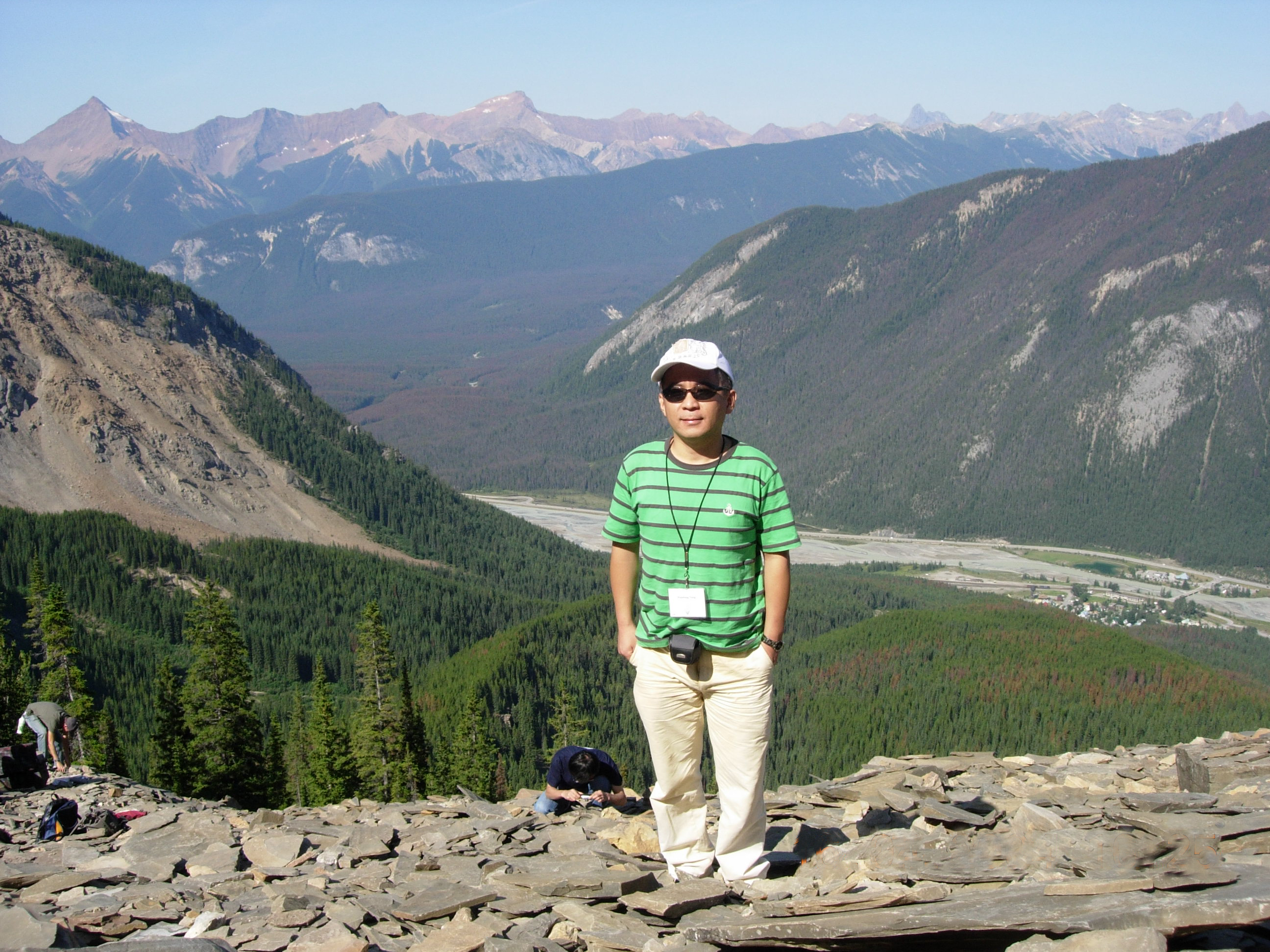
姓名:杨显峰
职称:副研究员
邮箱:yangxf@ynu.edu.cn
地址:云南省昆明市翠湖北路2号,云南大学云南省古生物研究重点实验室
邮编:650091
个人简介
杨显峰,博士,助理研究员,云南省九三学社社员,中国古生物学会会员,中国动物协会会员,中国自然科学博物馆协会会员。2008年7月入职云南省古生物研究重点实验室,目前主要从事澄江生物群门类古生物学,埋藏学和古生态学的研究。
学历教育(Education)
2004-2008 中国科学院南京地质古生物所 古生物学与地层学专业 博士学位
2001-2004 东北林业大学动物资源学院 动物生态学专业 硕士学位
1994-1998 哈尔滨师范大学生命与环境科学学院 生物学专业 学士学位
主持和参加的科研项目(Grants)
1、2022.01-2025.12,早寒武世澄江生物群(2统3阶)半索动物化石的新发现及其进化和古生态意义,国家自然基金地区基金(批准号42162001,主持人,在研)
2、2019.01-2021.12,滇东南晚寒武纪古丈中晚期特意埋藏福禄生物群,现代古生物和地层学国家重点实验室重点项目(批准号20191101,参加,在研)
3、2015.12-2019.12,滇东下寒武统海晏地区澄江生物群化石对比研究, 国家自然科学基金(批准号:41562001,主持人,结题)
4、2011.01-2013.12,早寒武世澄江动物群三叶形虫研究,国家自然科学基金地区科学基金项目(批准号:41062001,主持人,结题)
5、2007.12-2009.12,滇东南芙蓉世三叶虫及其地层学意义,国家自然科学基金(批准号:40602002,参与, 结题)
6、2007.12-2009.12,中国古生代重要层段综合地层学及其精细对比研究,中科院知识创新工程项目(批准号:KZCX2-YW-122,参与,结题)
7、2009.6-2012.6,早寒武世澄江动物群行为学研究,云南省教育厅科学研究基金重点项目(批准号:09Z0009,主持人,结题)
8、2009.12-2011.12,澄江动物群带有软体附肢的三叶虫研究,云南大学理工类校级课题(批准号:KL080020,结题)
9、2009.12-2012.12,早古生代澄江动物群节肢动物视觉系统的研究,云南省应用基础研究面上项目(批准号:2009CD005,主持人,结题)
10、2010.12-2012.12,早寒武世澄江动物群后生动物的视觉系统, 现代古生物学与地层学国家重点实验室开放基金(批准号:103113,主持人,结题)
讲授课程(Courses Taught)
古生物地史学/ Paleontology and Historical Geology
古生物学慕课-三叶虫专题
获得奖励(Honors)
2007年获得江苏省自然科学进步一等奖
目前研究兴趣(Research interests)
1.澄江动物群节肢动物的分类、系统和演化
2.寒武纪三叶虫生物地层学
近年参加编写的专著(Monograpy)
1.中国科学院南京地质古生物所主编.2013.金钉子-全球标准层型剖面和点位研究.浙江大学出版社.1-325页.(作者之一)
2.Edited by Peng Shanch,Loren E. Babcock, and Zhu Maoyan. 2005. Cambrian System of China and Korea guide to Field Excursions. University of Science and Technology of China Press.(作者之一)
近年发表主要论文和会议摘要(Publications)
Yang, X.-F., Peng, S.-C., Loren E. Babcock, Zhu, X.-J and Liu, Y. 2022. New species of Liostracina Monke, 1903 (Trilobita, Cambrian) from Yunnan, China: complete holaspid exoskeleton and implications for higher level classification,Journal of Paleontology,1-16. doi: 10.1017/jpa.2022.56.
Yang X.-F., Kimmig Julien, Zhai D.-Y., Liu Y., Kimmig S.R. and Peng S.-C.2021. A juvenile-rich palaeocommunity of the lower Cambrian Chengjiang biota sheds light on palaeo-boom or palaeo-bust environments. Nature Ecology & Evolution 5, 1082–1090.
Yang X.-F., Kimmig Julien, Bruce S. Lieberman and Peng S.-C.2020. A new species of the deuterostome Herpetogaster from the early Cambrian Chengjiang biota of South China. The Science of Nature,107;37.
Peng S-C, Yang X-F, Liu Y, Zhu X.-J. Sun H.-J., Samuel Zamor, Mao Y.-Y. and Zhang Y.-C..2020. Fulu biota, a new exceptionally-preserved Cambrian fossil assemblage from the Longha Formationin southeastern Yunnan. Palaeoworld 29, 453-461
Ou, Q, Jean Vannier, Yang X-F, Chen A.-L., Shu D.-G., Mai H.-J., Han J., Fu D.-J., Wang R, and Georg Mayer.2020. Evolutionary trade-off in reproduction of Cambrian arthropods. Science Advances, 6: eaaz3376
Yang X.-F., Johan Fredrik Bockelie et al. 2015. The first observation of complete Macrocystella from the Upper Cambrian (Furongian, Sandu Formation) of Guangxi province, South China. Geological Society of America Abstracts with Programs. Vol. 47, No. 7, p.573.
Yang X.-F., Olev Vinn, Hou X.-G. and Tian X.-L. 2013. New tubicolous problematic fossil with some “lophophorate” affinities from the Early Cambrian Chengjiang biota in south China. GFF,135(2):184-190.
Vannier Jean, Yang X.-F., Rudy Lerosey-Aubril, and David Legg. 2012. Waptia:a forgotten Burgess shale arthropod revisited. Newsletter of the Palaeontological Association,81:92.
Yang X.-F.2011.The first record of PARABLACKWELDERIA KOBAYASHI, 1942 from Laiwu and Xintai, Shandong, China and its stratigraphic significance. Journal of Stratigraphy,35(2):209-218(Chinese with English abstract)
Yang X.-F. 2011. New advances in the biostratigraphical study of the Kushan Formation of the Upper Cambrian, North China. Museum of Northern Arizona Bulletin 67:312-313.
Yang X.-F., Hou X.-G., and Tian X.-L. 2010. The study of clustered behavior from the early Cambrian Chengjiang Biota. Abstract volume of Papers from Palaeontological society of China (Chinese with English abstract). Pp:30-32.
Yang X.-F., Hou X.-G.2009.The oldest known example of trilobite ecdysis (Chengjiang biota, Cambrian). P.96. Edited by Martin Smith, Lorna O’ Brien and Jean Bernard Caron. International conference on the Cambrian explosion abstract volume.Pp.1-111.
Peng S.-C., Yang X.-F., and Nigel C. Hughes.2008. The old eye-stalked trilobite, Parablackwelderia Kobayashi, 1942 (Damesellinae, Cambrian) and its occurrence in Shandong, China . Journal of Palaeontology, 82(4):842–850
Yang X.-F., Peng S.-C. 2007. Two Junior Hononyms of Chinese Cambrian Trilobite Genera and their Replacement Names. Acta Palaeontologica Sinica, 46(4):491-492(Chinese with English abstract).
Yang X.-F., Zhou Z.-Q., Lin T-R, and Peng S.-C. 2005. Trilobite Fauna of Datong and Huzhu Area in Qilian Mountain Region, Qinhai and its stratigraphyic significance. Acta Micropalaeontontologica Sinica, 22:211-212(Supplement).
林天瑞,彭善池,周志强,杨显峰.2013.青海化隆拉脊山寒武纪多节类三叶虫.古生物学报,54(2):424-458.
唐兰、陈旭、杨杰、杨兴莲、丛培允、杨显峰、王欣、张举、宋妍妍、陈中阳、侯旭东、张琳娜、孙海静.2013.桂北兴安奥陶纪至志留纪初笔石序列的再研究。地层学杂志,37(1):1–7.
杨显峰,侯先光.2009.早寒武世澄江动物群后生动物的视觉系统. 中国古生物学会成立80周年纪念论文摘要集. 26-27页
杨显峰.2008.山东寒武系张夏组合崮山组过渡带的三叶虫生物地层及崮山阶底界的年代地层学.未出版的博士论文.